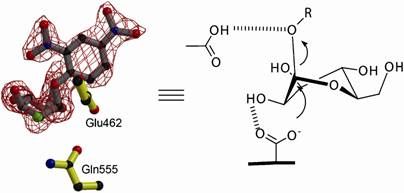Platinum Cages
Liposomes as blueprints for hollow platinum nanospheres
Advertisement
Tiny structures made of precious metals are of interest because of their broad spectrum of biomedical, catalytic, and optical applications. Porous nanospheres, for example, are ideal for catalytic applications that require large surfaces but can work at low concentration (and consequently with little material). Previous production methods had a disadvantage in that the spheres consisted of individual metallic nanoparticles; these were not very stable and only relatively small spheres were accessible. A team at the Sandia National Laboratories and the University of New Mexico in Albuquerque as well as the University of Georgia in Athens has now developed a clever new technique for the production of relatively large porous platinum nanocages. These spheres do not consist of individual particles, but of continuous, branched (dendritic) platinum sheets.
Liposomes are familiar to us from creams: the tiny balls of fat carry active ingredients through the skin. In the liposome that researchers working with John A. Shelnutt used as a blueprint, the mantle of fat consists of a double lipid layer. The narrow space between the two layers contains a light-activated catalyst, a tin-containing porphyrin compound. The liposomes are placed in a solution containing a platinum salt. When these liposomes are then irradiated with light, the photocatalyst transfers electrons to the platinum ions. The resulting uncharged platinum atoms gather into tiny clumps. Once these clumps reach a certain size, they also become active and catalyze the release of more platinum atoms from the platinum salt. Atom by atom, small, flat, branched platinum structures (dendrites) form within the double lipid layer. These continue to grow until all of the platinum salt is consumed. The important thing is to make sure that the number of tin photocatalyst molecules-and thus the initial number of platinum clumps-within the liposome double layer is very high. The resulting dendrites are then close enough to each other to grow into a network; this forms a solid but porous sphere with the same size and shape as the liposome. When the liposomes are broken up, the platinum spheres remain intact. Shelnutt, his collaborator Yujiang Song, and their team were able to produce spheres with diameters up to 200 nm. These platinum spheres aggregate into foam-like structures.
Original publication: John A. Shelnutt et al.; "Synthesis of Platinum Nanocages by Using Liposomes Containing Photocatalyst Molecules"; Angewandte Chemie International Edition 2006.
Other news from the department science
Most read news
More news from our other portals
See the theme worlds for related content
Topic world Synthesis
Chemical synthesis is at the heart of modern chemistry and enables the targeted production of molecules with specific properties. By combining starting materials in defined reaction conditions, chemists can create a wide range of compounds, from simple molecules to complex active ingredients.

Topic world Synthesis
Chemical synthesis is at the heart of modern chemistry and enables the targeted production of molecules with specific properties. By combining starting materials in defined reaction conditions, chemists can create a wide range of compounds, from simple molecules to complex active ingredients.































































